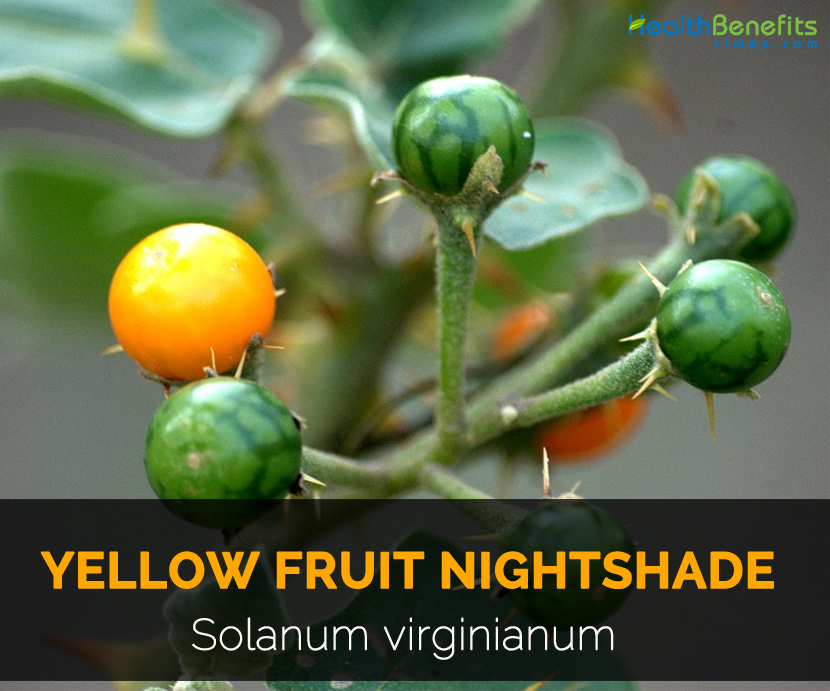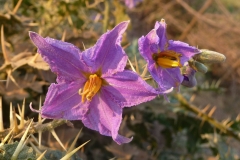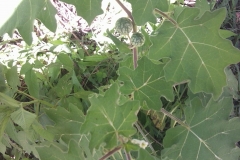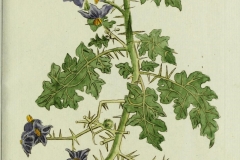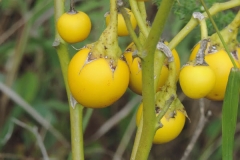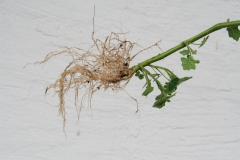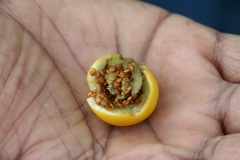The perennial herb grows to 1.2 meters tall with woody base and profusely branched stem. Young ones are clothed with dense tomentose and stellate hairs. Stems are green when young and brownish when matured. Leaves are elliptical ovate. Flowers are solitary, blue followed by a globular fruits. Prickles are straight, compressed, shining and glabrous about 1 to 3 cm long. Leaves are subpinnatifid, sinuate, ovate or elliptic, obtuse or subacute and stellately hairy on both sides. Petioles are stellately hairy and prickly. Flowers are solitary, bisexual, actinomorphic and slightly zygomorphic. Calyx is synsepalous, pricky and densely hairy. Corolla is sympetalous that ranges from forms with short tube. Petals are violet with deltoid, acute and hairy lobes. Stamens are distinct which alternate with lobes of corolla and adnate to corolla tube or perigynous zone. Anther filament is glabrous, long and anther opens by a pore. Gynoecium has single compound pistil of 2 carpels, a single style, superior ovary having 2 or rarely more locules. Ovary is glabrous and ovoid. A nectary disk is found around the base of ovary. Fruit is a septicidal capsule or berry which possesses a sweet smell and attracts livestock and wild herbivores. Seeds inside the fruit are glabrous.
Preparations with Yellow Fruit Nightshade
- Juice
- Extract
- Powder
- Tonic
Proper Dosage
- Juice: 5 to 10 ml
- Extract: 5 to 10 ml
- Powder: 3 to 6 gm
- Tonic: 5 to 10 ml
- It eliminates phlegm and mucus from bronchial tubes and also cure respiratory ailments such as asthma, cough and bronchitis.
- It strengthen stomach walls and improves nutrient absorption.
- It prevents the chances of intestinal infections.
- It also prevent accumulation of excessive fluids in tissues and cures dropsy.
- Gargle with Yellow Fruit Nightshade extract to provide relief from throat ailments.
- It is used to treat skin problems.
- Roots are used to maintain body temperature.
- It clears flatulence and constipation.
- In diabetic patients, it lowers blood sugar.
- It is used to reduce fertility and treat gonorrhea.
Therapeutic Uses
- Cough
Yellow Fruit Nightshade is an antitussive that lowers cough reflex and as an expectorant it thins mucus and also lowers its production. This plant clears airways and assures proper functioning of lungs.
- Asthma
Yellow Fruit Nightshade dilates bronchioles and reduces swelling and mucus formation. It prevents the conditions such as common cold, sinusitis and upper respiratory allergies.
- Urinary Disorders
As a diuretic, Yellow Fruit Nightshade upgrades the amount of salt and water expelled from body through urine. It also lowers blood pressure by eliminating salt from the body. As antibiotic, it halt the growth of bacteria and also treats symptoms associated with respiratory tract infections such as excessive or no micturition, burning micturition, weakness, vomiting and backache.
- Liver disorders
With hepatoprotective activity, it acts as an antioxidant and inhibit oxidation process by preventing cell damage caused due to free radicals. It regenerates new cells and maintains proper liver functioning. It upgrades liver metabolism.
- Acidity
Yellow Fruit Nightshade nullifies acidic content and lowers its production. It provides relief from acid reflux and symptoms associated to acidity such as constipation, heartburn, pain in abdomen and flatulence.
- Insect bite
Yellow Fruit Nightshade has antibiotic property that eliminates microbes and also lowers allergic reaction with its antihistamine properties. It provides relief from pain and inflammation and also lower fever.
- Gum problems
It acts as antibiotic that helps to lower plaque and destroys bacteria that causes plaque buildup. Plaque produces toxins which can irritate gum. Inflammation of gums results in bleeding and puffiness. It also reattaches gums to teeth and makes them strong and healthy.
Traditional uses
- The herb is useful for bronchial asthma, chest pain, cough, cure vomiting, hair fall, dropsy, scabies, itching and skin diseases.
- It is useful for healing wounds and cardiac diseases associated with edema.
- The herb is also found to be helpful for lowering headache and migraine.
- Plant decoction is used for treating gonorrhea.
- Roots are used as Ayurvedic tonic for lactating mothers.
- The paste of roots is used for treating hernia.
- Roots are used for flatulence and constipation.
- Apply the leaves locally to provide relief from muscle or body pain.
- For rheumatism, drink its juice mixed with black pepper.
- Berries juice is used for sore throat.
- Use smoked dried fruits in form of cigarette for curing toothache and dental infection.
- Seeds helps to treat dysmenorrheal and irregular menstruation.
- Seeds are beneficial in irregular menstruation and dysmenorrheal.
- Use the plant decoction for gonorrhea.
- Root poultice is used to treat piles.
- In Nepal root decoction is used twice a day for treating asthma, cough and chest pain.
- Use Yellow Fruit Nightshade to treat worms, hoarseness of voice, cold, dysuria, fever, spleen or stone in urinary bladder and enlargement of liver.
- Fumigate Yellow Fruit Nightshade to treat piles.
- To treat cough, use the root decoction with honey.
- Apply the root paste mixed with lemon to cure scorpion and snake bites.
- Flowers, fruits and stem provide relief from burning sensation in feet.
- Mix the juice with whey and ginger. This mixture is helpful in fevers.
Medicinal Uses
- Cough
Boil Yellow Fruit Nightshade plant or panchang (3-4 gm) in 200 ml water till the water is reduced to 50 ml. Filter it and drink it twice a day. It is an effective cure for chronic cough.
Or Mix 1-2 m of Yellow Fruit Nightshade juice with 1 tbsp. honey.
- Epilepsy
Put 2 drops of Yellow Fruit Nightshade leaves juice in each nostril empty stomach in the morning.
- Liver Swelling and infection
It acts as a great liver tonic. Use the decoction for liver infection and liver swelling.
- Migraine
Put 4 drops of Yellow Fruit Nightshade juice in each nostril to treat chronic migraine.
- Hair fall
Massage the scalp with Yellow Fruit Nightshade leaves juice in order to cure dandruff and hair fall.
- Toothache
Apply leaves juice (Yellow Fruit Nightshade) on tooth with the use of cotton.
- Abscess
Fry Yellow Fruit Nightshade in little Almond oil. Let it cool and apply it on affected parts.
- Headache
Fry handful of dried Yellow Fruit Nightshade leaves. Strain it and apply the lukewarm oil on the scalp.
- Joint Pain
Fry Yellow Fruit Nightshade leaves in Sesame oil. Apply the lukewarm oil on affected part once a day.
- Body odor
Apply the mixture of Yellow Fruit Nightshade leaves and sesame oil (while lukewarm) once a day.
- Dysuria
Intake 1/4 teaspoon of Yellow Fruit Nightshade juice (fruits) with a teaspoon of honey.
- Earache
Steam one cup of Yellow Fruit Nightshade pulp with sesame oil. Let it cool and then strain. Apply it as ear drop regularly.
- Leprosy
Heat the mixture of 1/4 cup of sesame oil and 1 cup pulp of Yellow Fruit Nightshade fruit. Apply on the affected part while it is lukewarm.
- Toothache
Inhale the smoke of burnt Yellow Fruit Nightshade seeds once a day.
- Swelling
Apply the paste of crushed fruits to swollen parts.
- Ascaris
Take the root decoction twice in a day.
- Respiratory diseases
Boil 10 g of Yellow Fruit Nightshade roots in a cup of water. Drink it once a day.
- Back pain
Take 30 ml of root decoction regularly.
- Cough
Prepare a decoction with 30 g dried seeds of Yellow Fruit Nightshade. Drink (10 ml) thrice a day.
- Rheumatism
Extract the juice of Yellow Fruit Nightshade leaves. Take this juice (30 ml) daily by adding 5 g of black pepper powder.
- Gum diseases
Boil the plant of Yellow Fruit Nightshade till the water is reduced to half. Use it for swish. For better results add Black mustard
- Menstrual disorders
Take 1/2 tsp. of Yellow Fruit Nightshade seeds with lukewarm water once a day.
Ayurvedic Properties
- Rasa: Katu (pungent), tikta (bitter)
- Veerya: Ushna (hot)
- Guna: tikshna (sharp), Laghu (light), rukshna (dry)
- Dosha: Pacifies kapha and vata
- Vipaka: Katu (pungent)
Precautions
- Avoid Yellow Fruit Nightshade at the time of pregnancy.
- Use the herb after consulting the health practitioner.
References:
https://pdfs.semanticscholar.org/ee0d/ac1b05568b54de1c0be0a786560e49251fe4.pdf
https://www.japsonline.com/admin/php/uploads/2882_pdf.pdf
https://www.itis.gov/servlet/SingleRpt/SingleRpt?search_topic=TSN&search_value=821244#null
https://en.wikipedia.org/wiki/Yellow-fruit_nightshade
https://sites.google.com/site/efloraofindia/species/m—z/s/solanaceae/solanum/solanum-virginianum
https://www.astrogle.com/ayurveda/yellow-berried-nightshade-usage-in-curing-health-ailments.html
http://www.medicinalplantsindia.com/yellow-berried-nightshade.html
https://wikivisually.com/wiki/Yellow-fruit_nightshade
http://www.krishnaherbals.com/solanum-xanthocarpum.html
https://herbpathy.com/Uses-and-Benefits-of-Solanum-Xanthocarpum-Cid1087
https://www.homeremediess.com/solanum-xanthocarpum-medicinal-use-and-pictures/
Comments
comments
| Yellow Fruit Nightshade Quick Facts | |
|---|---|
| Name: | Yellow Fruit Nightshade |
| Scientific Name: | Solanum virginianum |
| Origin | Haryana, Gujarat, Madhya Pradesh and Rajasthan, found commonly on roadsides and wastelands. |
| Colors | Yellow |
| Shapes | Berry, globose, green; 1.25–2 cm in diameter |
